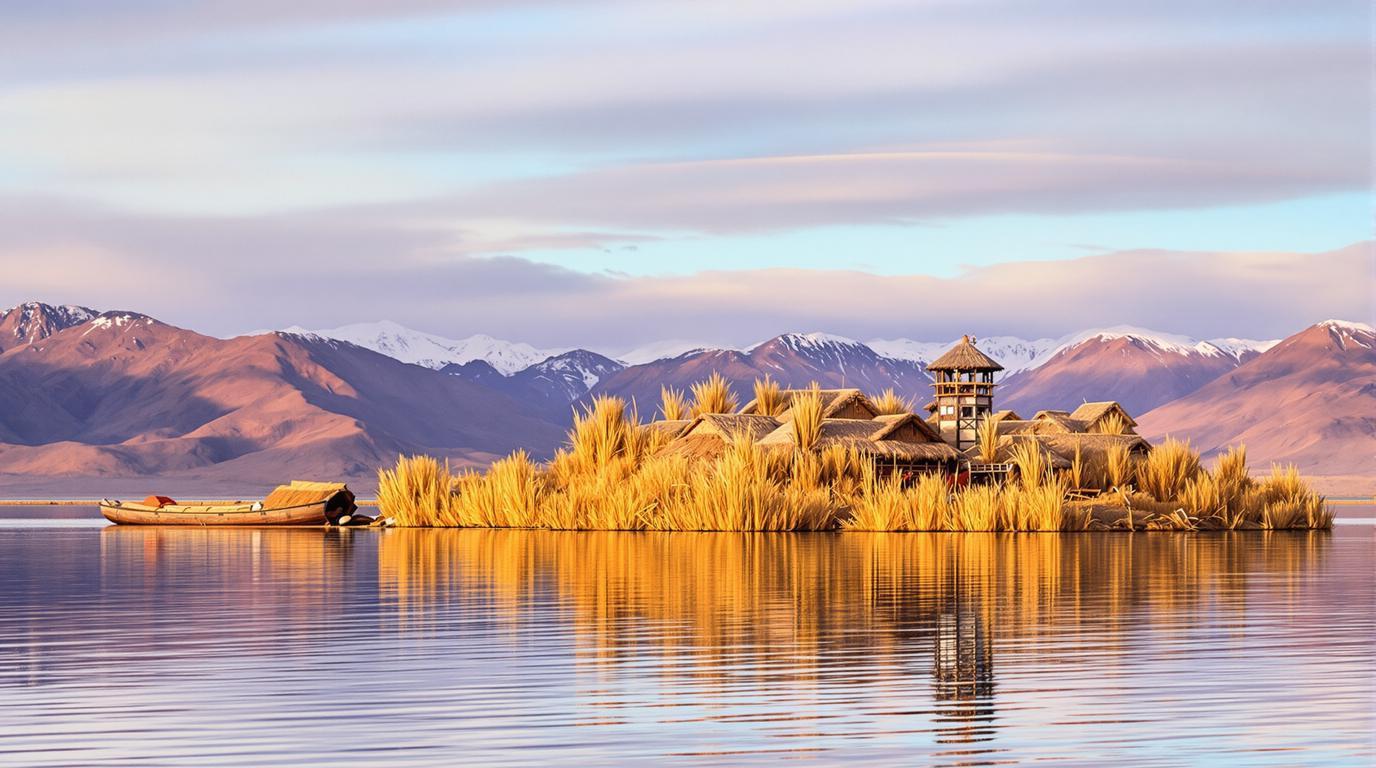# Lake Titicaca: The Ancient Floating World Atop the Andes
Where the borders of Peru and Bolivia meet, nearly 13,000 feet above sea level, lies a realm of floating islands, timeless traditions, and crystalline waters that stretch to the horizon. Lake Titicaca isn’t just the world’s highest navigable lake—it’s a living museum of pre-Columbian cultures and breathtaking Andean landscapes that few travelers truly explore beyond the tourist hubs.
## A Sky-High Maritime Marvel
Lake Titicaca commands attention with its staggering statistics: covering over 3,200 square miles at an elevation of 12,506 feet above sea level, it’s not only the highest commercially navigable lake globally but also South America’s largest lake. The sapphire waters—reaching depths of 922 feet—shimmer under the intense Andean sun, creating a mesmerizing contrast against the rugged mountain backdrop.
> “Our ancestors believed Lake Titicaca was the birthplace of the sun,” explains Manuel, an Indigenous guide from Isla del Sol. “When you watch sunrise here, with golden light dancing across the water, you understand why they considered this place sacred.”
## The Floating Marvels of Uros
Perhaps nothing captures the imagination quite like the Uros Islands—over 120 floating platforms entirely handcrafted from totora reeds. These golden islands aren’t merely tourist attractions but living communities where residents have maintained their distinctive way of life for centuries.
Walking on an Uros island feels like stepping onto a waterbed—the surface gently gives way beneath your feet. Families continually layer fresh reeds atop their islands, creating homes, boats, and even watchtowers from the same sustainable material that forms their foundation.
## Beyond the Tourist Trail: Taquile and Amantani
While day-trippers flock to the closest Uros islands, the lake’s true cultural treasures await on Taquile and Amantani. On Taquile, UNESCO-recognized textile traditions continue, with men publicly knitting elaborate hats and belts that indicate their marital status and community standing.
Amantani offers an even more immersive experience through homestays with local families. Here, electricity remains limited, and the island’s two ceremonial peaks—Pachatata (Father Earth) and Pachamama (Mother Earth)—provide sweeping panoramas that stretch to Bolivia.
## The Bolivian Side: Copacabana and Isla del Sol
The Bolivian shores offer a distinctly different experience. Copacabana serves as the gateway to Isla del Sol, where Inca ruins dot the landscape, including the sacred Chincana labyrinth and Pilkokaina temple.
> “Every stone here tells a story of our Inca heritage,” says Bolivian archaeologist Lucia Alvarez. “The island’s 200+ ruins represent one of the most concentrated archaeological sites in South America.”
## Surviving the Altitude Challenge
Visitors must respect the extreme elevation. Altitude sickness can affect even seasoned travelers, making gradual acclimatization essential.
“Take the first day slowly, drink coca tea, and avoid alcohol,” advises Dr. Carlos Mendoza, a high-altitude specialist in Puno. “Your body needs time to adjust to the reduced oxygen levels.”
## When Ancient Traditions Meet Modern Challenges
Tourism brings both opportunities and challenges to Lake Titicaca’s communities. On the heavily visited Peruvian side, some traditions risk becoming performances rather than lived experiences. Meanwhile, on Bolivia’s shores, communities work to balance preservation with economic development.
For travelers seeking authentic experiences, consider visiting during Candelaria Festival (February) when the region erupts in vibrant processions, or explore other remarkable natural wonders that have shaped human understanding.
## Practical Connections
Most visitors arrive via Puno (Peru) or Copacabana (Bolivia). For the adventurous, consider the train journey from Cusco to Puno, which rivals other spectacular cross-border natural wonders for scenic beauty.
Accommodations range from basic homestays to luxury experiences like Titilaka Lodge, where panoramic windows frame the lake’s vastness. Much like certain paradise islands with strict building codes, Lake Titicaca’s communities maintain traditional architecture that harmonizes with the landscape.
## Between Two Worlds
Lake Titicaca exists in a liminal space—between two countries, between earth and sky, between ancient traditions and modern realities. Similar to hidden Mediterranean villages where mountains meet the sea, this high-altitude wonder offers unexpected perspectives.
The lake reveals itself differently depending on your approach—whether through historical exploration like ancient command posts in medieval villages or through cultural immersion with local families.
As the sun sets behind the Andes, painting the lake in deepening shades of blue and purple, Lake Titicaca reminds us that some places aren’t simply destinations—they’re portals to understanding our relationship with the earth, the heavens, and each other.
